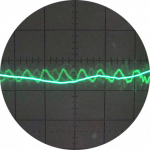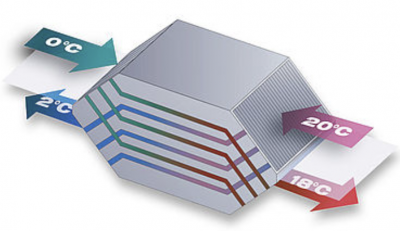Plastic heat exchangers are usually used inside MVHR units. For an air:air heatexchanger, there's not that much heat transfer needed across that plastic barrier (as the air conductivity is poor) so thin plastic is ok. Along the heat exchanger material we want low thermal conductivity, from the hot to cold end - so for this reason, plastic is preferred over metal. Piccy of I think what's in our MVHR core.
It does sound as though your unit is in permanent bypass then, so the heat exchanger core isn't being used. Some flaps open up inside the MVHR box, bypassing the core entirely. I suggest that you get a copy of the installation and user manuals, perhaps they can help. Certainly our own Vent Axia Sentinel Kinetic can be easily told not to use summer bypass ever, irrespective of temperature sensors - it's a user adjustment not installer on ours.
What unit do you have ?
Posted by: @roblFor an air:air heatexchanger, there's not that much heat transfer needed across that plastic barrier (as the air conductivity is poor) so thin plastic is ok.
Along the heat exchanger material we want low thermal conductivity, from the hot to cold end
Can I ask what is the purpose of a heat exchanger?
@dandee A heat exchanger is used to transfer (in this instance anyway) warmth from the air that is about to be exhausted from the house (stale air) and that energy is used to heat the colder air being introduced to the house as fresh air from outside before it is distributed in the property. Basically a surface conducts the heat from the exhaust air and applies it to the incoming fresh air. Regards, Toodles.
Toodles, he heats his home with cold draughts and cooks his food with magnets.
Posted by: @fazelCan I ask what is the purpose of a heat exchanger?
That question is a great leveller. 🙂
It shows the rest of us how we quickly descend into the technical depths!
In general terms a heat exchanger transfers heat between two fluids (liquids or gasses), whilst keeping those fluids separate.
The radiator of a car is a simple heat-exchanger.
Heat from the engine is passed into cooling water.
That water is pumped through the radiator, which has thin metal fins to transfer the heat into a stream of air.
The water and the air don't come into direct contact.
Within a household ventilation system (MVHR) there is a heat exchanger with a much larger surface area.
Hot, humid, sticky air is sucked out of shower/bath-rooms and kitchens.
As it passes through the heat exchanger, the heat is passed to fresh air being drawn in from outside the home.
The separation between the two streams of air means that the cooking smells from the kitchen, and the humid atmosphere from a shower cannot pass into the fresh air.
Save energy... recycle electrons!
Posted by: @fazelPosted by: @roblFor an air:air heatexchanger, there's not that much heat transfer needed across that plastic barrier (as the air conductivity is poor) so thin plastic is ok.
Along the heat exchanger material we want low thermal conductivity, from the hot to cold end
Can I ask what is the purpose of a heat exchanger?
Ohh boi, it was a rhetorical question, see the bold highlighted statements about the heat exchanger.
Placing the quoted phrases in a bold font was too subtle for me @dandee
I'd need at least one smilie to grab my attention. 🙂
As a member of a Community Energy group, I'm not daunted by receiving very basic questions from members of the public (or politicians!).
Save energy... recycle electrons!
The heat exchanger material conductivity is actually a compromise. Through the material, the thin way, we want high conductivity. Along the material there is a parasitic loss mechanism, for which we want low conductivity. Plastic is a better compromise of these two competing requirements than Aluminium is for an Air:Air heat exchanger - as the air boundary layer has an effective conductivity which is quite low there's little point using Aluminium or Copper as it won't improve performance noticeably, while the parasitic losses would shoot up. For a water:water heat exchanger plastic would be a poor choice, and a metal would generally be chosen.
Discussion on a forum is actually a compromise. Through this medium we actually want high transmissivity of information. Along the discussion there is a inherent loss-mechanism, through which we experience periods of low communication...
... which is why @robl is still posting coherent technical descriptions of the physics behind the design of heat exchangers, 25-hours after @dandee told us it was a "rhetorical question". 🤣
But hey... it's Friday!
and I've just enjoyed reading an erudite explanation of parasitic losses. 😉
Save energy... recycle electrons!
Posted by: @roblThe heat exchanger material conductivity is actually a compromise. Through the material, the thin way, we want high conductivity. Along the material there is a parasitic loss mechanism, for which we want low conductivity. Plastic is a better compromise of these two competing requirements than Aluminium is for an Air:Air heat exchanger - as the air boundary layer has an effective conductivity which is quite low there's little point using Aluminium or Copper as it won't improve performance noticeably, while the parasitic losses would shoot up. For a water:water heat exchanger plastic would be a poor choice, and a metal would generally be chosen.
Sorry I'm struggling to understand this. I'll try to play back what I've got from you: We want to conduct air from the outgoing (warm) side to the incoming (cold) side. For this, we need a thin material that has high conductivity in the perpendicular direction, to allow transfer across the interface. However, because the air passage is quite long, we don't want the material itself to be leeching heat away from the warm air and transporting it laterally along the length of the material: we want it transfering perpendicularly across the interface only. So plastic is better for this.
However, I still don't feel like I really "grok" the explanation. Nor can I explain why we want plastic for air:air but metal for water:water.
If you don't want to explain it again (which is totally understandable!) do you have any suggestions for where I can look this up?
ASHP: Mitsubishi Ecodan 8.5kW
PV: 5.2kWp
Battery: 8.2kWh
@scrchngwsl You have already noted that for efficient counter-current heat transfer, you want to avoid heat transfer within the fluid streams. In each fluid, there is a laminar boundary layer which constitutes the major resistance to heat transfer to the interface. There is then the heat transfer perpendicular through the exchanger surface as well as that within the plane of the exchanger surface. The exchanger plate thickness is minimised (and length of exchanger maximised) to maximise flow across plate rather than along it. Flux through plate is proportional to delta-T across plate surface while flux within plate is proportional to temperature gradient along plate.
However, the boundary layer in air poses at least an order of magnitude more resistance than water and heat flux through an air boundary layer is going to be correspondingly lower. At this lower heat flux, the delta-T across the plate will be also correspondingly reduced but the gradient along plate will not (I still want to shift that amount of heat in that distance). The lateral flow of heat within the plate will therefore start to dominate, particularly if the plate has a high conductivity. I am therefore willing to use a lower conductivity plate material (which will result in a higher delta-T) to shift the balance back towards transfer across plate.
It was just yesterday that James posted
Posted by: @jamespipeHello! I'm not a tech-savvy person. I'd like the moderators and other members to dumb down the complex subjects to my level. 😀
Have we achieved that yet, James? 😉
Save energy... recycle electrons!
@ronin92 thanks a lot, that cleared it up for me!
ASHP: Mitsubishi Ecodan 8.5kW
PV: 5.2kWp
Battery: 8.2kWh
- 26 Forums
- 2,122 Topics
- 46.6 K Posts
- 87 Online
- 4,529 Members
Join Us!
Podcast Picks
Latest Posts
-

There are some projects looking at how smart meters and...
By Jeff , 3 hours ago
-

RE: Share Your Experiences with Heat Pump Manufacturer Support
@terry1812 Yes, I use Homely, as to whether Daikin is u...
By Toodles , 15 hours ago
-

RE: ASHP heat output monitoring
@carlo - welcome to the forum. I don't know about LG...
By cathodeRay , 20 hours ago
-

RE: Why do we need pressurised systems?
@old_scientist If that were the case (and it might well...
By Toodles , 24 hours ago
-
RE: 300 Liter Tank - Do I have to heat it all?
There’s no second hand market for DHW tanks (I was told...
By Judith , 1 day ago
-

RE: Solar Power Output – Let’s Compare Generation Figures
We had an excellent four months (11/3 to 15/7) generati...
By JulianC , 2 days ago
-
RE: Is this just haze or something more?
I think the present somewhat cooler hazy days show the ...
By Judith , 2 days ago
-
RE: My misgivings about installing ASHP and solar panels via the ECO4 scheme...
All noted and accepted and as I say I am sorry that you...
By JamesPa , 2 days ago
-
I think it is very much me that is sitting outside the ...
By Grantmethestrength , 2 days ago
-
RE: Replacing Refrigerant on Mitsubishi Heat Pump
@davidalgarve It should just be recovered by both servi...
By dgclimatecontrol , 3 days ago
-

RE: Who's your electricity provider and what's your tariff?
Aggregators have been recognised for many years, and it...
By Transparent , 3 days ago
-
RE: Help me keep the faith with my air source heat pump installation
Great news I edited my previous post (probably af...
By JamesPa , 3 days ago
-
RE: Double or Triple Glazed Windows?
@toodles Glad to hear things are progressing well for y...
By TRBob , 3 days ago
-

How to waste energy (and time) playing with AI.
A friend of mine who subscribes to an AI service was ex...
By Toodles , 4 days ago
-

RE: Heat Pump Books For Beginners – Bodge Buster & From Zero To Heat Pump Hero
@topher you’re more than welcome to, yes. I’ll send you...
By Mars , 5 days ago
-

RE: Fitting new shower valve ..........
I’ve never taken a chance when fiddling and changing ou...
By Mars , 5 days ago
-
You should contact the council and report the unsatisfa...
By JamesPa , 5 days ago
-

RE: Benefits of an extra horizontal loop for GSHP
I would deffo install an additional slinky run, especia...
By Transparent , 5 days ago




